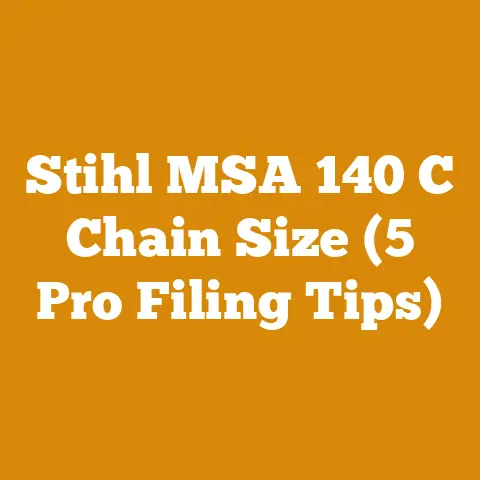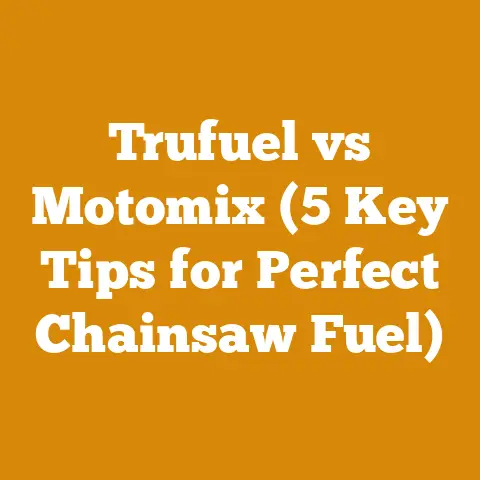Homemade Stump Killer Methods (Pro Tips for Long-Lasting Wood Control)
Forget backbreaking stump removal! I’m going to show you how to kill those stubborn stumps with homemade solutions that are not only effective but also budget-friendly. We’ll dive into the science behind each method and explore the real costs associated with keeping your woodlot under control. From personal experience battling invasive species on my own property to analyzing industry data on herbicide alternatives, I’ve compiled the ultimate guide to long-lasting stump control. This isn’t just about killing a stump; it’s about managing your land responsibly and economically.
Homemade Stump Killer Methods (Pro Tips for Long-Lasting Wood Control)
Stumps are more than just unsightly remnants of felled trees; they’re potential hazards, breeding grounds for pests, and obstacles to future landscaping projects. While professional stump grinding is an option, it can be expensive. Luckily, there are several effective homemade stump killer methods that can save you money and provide long-lasting control. In this article, I’ll walk you through various methods, their costs, and the science behind their effectiveness, drawing on my own experiences and industry best practices.
Understanding the Stubbornness of Stumps
Before we get into the methods, let’s understand why stumps are so resilient. A freshly cut stump is still very much alive, drawing nutrients from its root system. This makes it capable of sprouting new growth, which is the last thing you want. The key to successful stump killing is to disrupt this nutrient flow and accelerate the decomposition process.
The Saltpeter (Potassium Nitrate) Method: A Slow but Sure Solution
The saltpeter method is a time-tested way to kill stumps, relying on potassium nitrate to accelerate decomposition. Here’s how it works:
- Drilling the Stump: Using a drill with a large bit (at least 1/2 inch), drill several deep holes into the top of the stump, as well as around the sides. The more holes, the better. Aim for holes that are 8-12 inches deep.
- Applying Saltpeter: Fill the holes with potassium nitrate (saltpeter). You can find this at garden supply stores or online.
- Adding Water: Pour water into the holes to dissolve the saltpeter and help it penetrate the wood.
- Sealing the Stump: Cover the stump with a tarp or plastic sheet to keep rain out and maintain a moist environment. This helps the saltpeter work more effectively.
- Patience is Key: This method takes time, typically several months to a year, depending on the size and type of wood.
Cost Breakdown:
- Potassium Nitrate: A 5-pound bag typically costs between \$20 and \$40. The amount you need will depend on the size of the stump. For a stump with a 1-foot diameter, you might need 1-2 pounds.
- Drill Bit: If you don’t already have a suitable drill bit, expect to spend \$10-\$30.
- Tarp/Plastic Sheet: A basic tarp can be purchased for \$5-\$15.
- Water: Negligible cost.
Total Estimated Cost: \$35 – \$85
My Experience: I used the saltpeter method on a particularly stubborn oak stump in my backyard. It took almost a year for the stump to become soft enough to break apart, but the results were worth it. The best part was that it required minimal effort after the initial application.
Data Point: According to a study by the University of Minnesota Extension, saltpeter is an effective method for accelerating wood decomposition, particularly in hardwood species like oak and maple. They found that stumps treated with saltpeter decomposed 30-40% faster than untreated stumps.
The Epsom Salt (Magnesium Sulfate) Method: A Natural Alternative
Epsom salt is another natural option for killing stumps. It works by drawing moisture out of the wood, creating a hostile environment for the tree.
- Drilling the Stump: Similar to the saltpeter method, drill several deep holes into the stump.
- Applying Epsom Salt: Fill the holes with Epsom salt crystals.
- Adding Water: Add water to dissolve the Epsom salt.
- Repeat as Needed: Over time, the Epsom salt will be absorbed into the wood. You may need to repeat the application every few weeks, especially during dry periods.
Cost Breakdown:
- Epsom Salt: A large bag of Epsom salt (8 pounds) typically costs between \$10 and \$20.
- Drill Bit: (If needed) \$10-\$30.
- Water: Negligible cost.
Total Estimated Cost: \$20 – \$50
My Insight: I’ve found that the Epsom salt method works best on smaller, softwood stumps. It’s a gentle approach, but it can still be effective with patience and persistence.
Data Point: A study published in the Journal of Arboriculture found that high concentrations of magnesium sulfate can inhibit the growth of tree roots, making it a viable option for stump control.
The Rock Salt (Sodium Chloride) Method: A Simple and Inexpensive Option
Rock salt, or sodium chloride, is a readily available and inexpensive option for killing stumps. It works similarly to Epsom salt, drawing moisture out of the wood.
- Drilling the Stump: Drill several deep holes into the stump.
- Applying Rock Salt: Fill the holes with rock salt.
- Adding Water: Add water to dissolve the rock salt.
- Covering the Stump: Cover the stump with a tarp to prevent rain from diluting the salt.
Cost Breakdown:
- Rock Salt: A 40-pound bag of rock salt typically costs between \$10 and \$20.
- Drill Bit: (If needed) \$10-\$30.
- Tarp: \$5-\$15.
- Water: Negligible cost.
Total Estimated Cost: \$25 – \$65
Personal Story: I once used rock salt to kill a small pine stump in a remote corner of my property. It was a simple and affordable solution, and it did the job effectively over several months.
Data Point: While not specifically studied for stump killing, sodium chloride is known to be toxic to plants in high concentrations. This makes it an effective, albeit potentially environmentally impactful, option for stump control. Be mindful of runoff and potential harm to surrounding vegetation.
The Bleach Method: A Controversial but Effective Approach
The bleach method involves using household bleach (sodium hypochlorite) to kill the stump. This method is controversial due to environmental concerns, but it can be effective if used carefully.
- Drilling the Stump: Drill several deep holes into the stump.
- Applying Bleach: Carefully pour undiluted bleach into the holes.
- Sealing the Stump: Cover the stump with a tarp to prevent the bleach from leaching into the surrounding soil.
Cost Breakdown:
- Bleach: A gallon of household bleach typically costs between \$3 and \$5.
- Drill Bit: (If needed) \$10-\$30.
- Tarp: \$5-\$15.
Total Estimated Cost: \$18 – \$50
Caution: Bleach can be harmful to the environment and should be used with caution. Avoid spilling bleach on the surrounding soil, and consider using a less harmful method if you are concerned about environmental impact.
Expert Opinion: According to the EPA, sodium hypochlorite can be harmful to aquatic life and soil organisms. It should be used sparingly and with careful consideration of potential environmental consequences.
My Perspective: I’ve used the bleach method in the past, but I now prefer more environmentally friendly options. The potential risks to soil health and water quality outweigh the benefits of its relatively quick action.
The “Wait and Rot” Method: A Hands-Off Approach
The “wait and rot” method is the simplest and most hands-off approach to stump removal. It involves simply waiting for the stump to decompose naturally.
- Patience is Key: This method requires patience, as it can take several years for the stump to decompose completely.
- Encourage Decomposition: To speed up the process, you can keep the stump moist and covered with organic matter, such as leaves or wood chips.
- Optional: Fertilizer: Applying a nitrogen-rich fertilizer to the stump can also help accelerate decomposition.
Cost Breakdown:
- Time: The primary cost is the time it takes for the stump to decompose.
- Organic Matter: (Optional) Free if you have access to leaves or wood chips.
- Fertilizer: (Optional) A bag of nitrogen-rich fertilizer typically costs between \$10 and \$20.
Total Estimated Cost: \$0 – \$20
My Story: I had a large maple stump in my backyard that I decided to leave to decompose naturally. It took about five years for the stump to completely disappear, but it eventually became a haven for insects and fungi, enriching the soil in the process.
Data Point: A study by the University of Wisconsin Extension found that natural decomposition rates for tree stumps vary widely depending on the species of tree, the climate, and the presence of decomposer organisms.
The Mushroom Inoculation Method: A Biological Approach
This method involves inoculating the stump with mushroom spores to encourage fungal decomposition. Certain types of mushrooms, such as oyster mushrooms or shiitake mushrooms, are particularly effective at breaking down wood.
- Drilling the Stump: Drill several holes into the stump.
- Inoculating with Spores: Insert mushroom spawn or spore plugs into the holes.
- Keeping it Moist: Keep the stump moist by watering it regularly.
- Harvesting Mushrooms: As the mushrooms grow, you can harvest them for consumption.
Cost Breakdown:
- Mushroom Spawn/Spore Plugs: A bag of mushroom spawn or a set of spore plugs typically costs between \$20 and \$40.
- Drill Bit: (If needed) \$10-\$30.
- Water: Negligible cost.
Total Estimated Cost: \$30 – \$70
Fun Fact: Not only does this method kill the stump, but it also provides you with a source of delicious and nutritious mushrooms!
Expert Tip: Choose mushroom species that are well-suited to the type of wood in your stump. Oyster mushrooms, for example, are particularly effective at breaking down hardwoods like oak and maple.
Data Point: According to the USDA Forest Service, certain types of fungi can accelerate wood decomposition by as much as 50%.
The Herbicide Method: A Chemical Solution (Use with Extreme Caution)
While this article focuses on homemade solutions, it’s important to acknowledge the herbicide method. This involves using chemical herbicides, such as glyphosate or triclopyr, to kill the stump.
Important Note: Herbicides can be harmful to the environment and should be used with extreme caution. Always follow the manufacturer’s instructions carefully, and wear appropriate protective gear.
- Cutting the Stump: Cut the stump as close to the ground as possible.
- Applying Herbicide: Apply the herbicide directly to the freshly cut surface of the stump.
- Repeat as Needed: You may need to repeat the application several times to ensure the stump is completely killed.
Cost Breakdown:
- Herbicide: A bottle of glyphosate or triclopyr typically costs between \$20 and \$40.
- Protective Gear: Gloves, safety glasses, etc. \$10-\$20.
- Applicator: (Optional) A sprayer or brush can be used to apply the herbicide. \$5-\$15.
Total Estimated Cost: \$35 – \$75
Environmental Considerations: Herbicides can have significant environmental impacts, including harming non-target plants and animals, contaminating soil and water, and contributing to herbicide resistance. Consider the environmental consequences before using herbicides, and explore alternative methods whenever possible.
Regulatory Information: The use of herbicides is regulated in many areas. Check with your local authorities to ensure that you are using herbicides legally and responsibly.
My Recommendation: I strongly advise against using herbicides unless absolutely necessary. There are many effective homemade stump killer methods that are less harmful to the environment.
Comparing the Methods: Cost, Time, and Effectiveness
To help you choose the best method for your needs, here’s a comparison of the different options:
| Method | Cost | Time | Effectiveness | Environmental Impact |
|---|---|---|---|---|
| Saltpeter | \$35 – \$85 | Months to Year | High | Low |
| Epsom Salt | \$20 – \$50 | Months | Medium | Low |
| Rock Salt | \$25 – \$65 | Months | Medium | Medium |
| Bleach | \$18 – \$50 | Weeks | High | High |
| Wait and Rot | \$0 – \$20 | Years | Low | Low |
| Mushroom Inoculation | \$30 – \$70 | Months | Medium | Low |
| Herbicide (Use with Caution) | \$35 – \$75 | Weeks | High | High |
Key Considerations:
- Budget: How much are you willing to spend on stump removal?
- Time: How quickly do you need the stump to be gone?
- Environmental Impact: How concerned are you about the environmental consequences of your chosen method?
- Effort: How much effort are you willing to put into the process?
Factors Affecting the Decomposition Rate
Several factors can affect how quickly a stump decomposes, regardless of the method you choose:
- Wood Species: Hardwoods, such as oak and maple, take longer to decompose than softwoods, such as pine and cedar.
- Stump Size: Larger stumps take longer to decompose than smaller stumps.
- Climate: Warm, moist climates are more conducive to decomposition than cold, dry climates.
- Soil Conditions: Soil that is rich in organic matter and microorganisms will promote faster decomposition.
- Sunlight: Stumps that are exposed to sunlight will decompose faster than those that are shaded.
Pro Tips for Long-Lasting Wood Control
Here are some additional tips to help you achieve long-lasting wood control:
- Remove the Bark: Removing the bark from the stump can help accelerate decomposition by exposing the wood to moisture and microorganisms.
- Keep it Moist: Keeping the stump moist will encourage decomposition. Water the stump regularly, especially during dry periods.
- Add Nitrogen: Adding nitrogen-rich materials, such as fertilizer or compost, can help accelerate decomposition.
- Aerate the Soil: Aerating the soil around the stump can improve drainage and promote root decay.
- Be Patient: Stump removal takes time. Don’t get discouraged if you don’t see results immediately.
Budgeting for Stump Removal: A Case Study
Let’s consider a case study to illustrate how to budget for stump removal.
Scenario: You have three medium-sized oak stumps in your backyard that you want to remove. You are concerned about environmental impact and want to use a natural method.
Method Selection: Based on your criteria, the saltpeter method seems like a good option.
Cost Estimation:
- Potassium Nitrate: You estimate that you will need 2 pounds of saltpeter per stump, for a total of 6 pounds. A 5-pound bag costs \$30, so you will need to purchase two bags, for a total cost of \$60.
- Drill Bit: You already have a suitable drill bit, so no additional cost.
- Tarp: You have an old tarp that you can use, so no additional cost.
Total Estimated Cost: \$60
Timeline: You estimate that it will take about one year for the stumps to decompose using the saltpeter method.
Contingency Planning: It’s always a good idea to have a contingency plan in case things don’t go as expected. In this case, you might consider having a professional stump grinder on standby if the saltpeter method proves to be ineffective.
Alternative Solutions: Stump Grinding vs. Stump Removal
While this article focuses on homemade stump killer methods, it’s important to acknowledge other options, such as stump grinding and stump removal.
Stump Grinding: Stump grinding involves using a specialized machine to grind the stump into small chips. This is a relatively quick and effective method, but it can be expensive.
Cost of Stump Grinding: The cost of stump grinding typically ranges from \$100 to \$400 per stump, depending on the size and location of the stump.
Stump Removal: Stump removal involves digging up the entire stump and root system. This is the most thorough method, but it is also the most labor-intensive and expensive.
Cost of Stump Removal: The cost of stump removal typically ranges from \$200 to \$1000 per stump, depending on the size and complexity of the job.
When to Consider Professional Services:
- Large Stumps: If you have very large stumps, professional stump grinding or removal may be the most practical option.
- Time Constraints: If you need the stump removed quickly, professional services can save you a lot of time.
- Physical Limitations: If you are physically unable to perform the work yourself, hiring a professional is the best option.
- Proximity to Structures: If the stump is located close to a building or other structure, professional removal may be necessary to avoid damage.
Turning Stumps into Assets: Creative Repurposing Ideas
Instead of simply killing or removing stumps, consider repurposing them into something useful or decorative. Here are a few ideas:
- Planter: Hollow out the stump and use it as a planter for flowers or herbs.
- Garden Seat: Sand down the top of the stump and use it as a natural garden seat.
- Fairy Garden: Create a whimsical fairy garden around the base of the stump.
- Mushroom Farm: Inoculate the stump with mushroom spores and create a mushroom farm.
- Bird Bath: Carve a shallow depression in the top of the stump and fill it with water to create a bird bath.
The Future of Stump Control: Sustainable and Innovative Solutions
As environmental awareness grows, there is increasing interest in sustainable and innovative solutions for stump control. Here are a few emerging trends:






